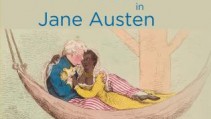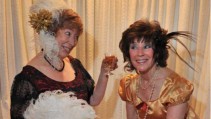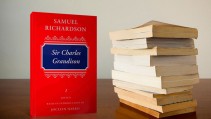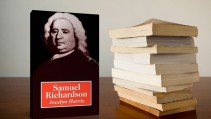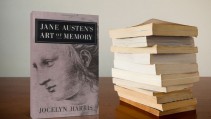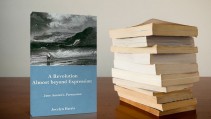“When once we are buried you think we are dead / But behold me Immortal,” declares St. Swithin—or perhaps Jane Austen herself—in “Venta,” a satiric poem written on July 15, 1817, three days before she died (Minor Works 452). Immortal indeed, for new resources such as databases of eighteenth- and nineteenth-century newspapers and journals, digitized manuscripts, online books, blogs, and search engines all open up cultural and historical contexts that bring her back to life. So do new books and editions in both print and e-book form; so do readily accessible articles in Persuasions and elsewhere. I am equally indebted to my fellow Janeites, for email allows us to send suggestions to one another, share discoveries, and build on what others have done both inside and outside the academy.
How the process of research has changed! As a young student, I sat for hours in the Victoria and Albert Museum Library, copying out Samuel Richardson’s correspondence into pages and pages of handwritten notes. Now, even though I live and work half a world away from the great libraries of Europe and North America, I can explore how Austen’s life and times inspired her creativity. So can we all.
Thanks to this new treasure-chest of resources, I found only the third instance of Austen’s name appearing in print in her lifetime, and learned about the atrocious weather that blighted her last years. To know that the young Prince of Wales lived near Steventon explained why she created so many wastrel characters in her novels, from John Thorpe to Tom Bertram, Frank Churchill, Sir Walter Elliot, and William Walter Elliot. To realize that Mrs. Austen’s cousin was Mme. d’Arblay’s neighbor raised suggestive possibilities about Fanny Burney’s misery at Court and Fanny Price’s at Mansfield Park, while further parallels between Mr. Price and Susan Burney’s brutal husband, Molesworth Phillips, led me to the whereabouts of a hitherto unknown portrait of him by Edward Burney. Similarities between George III and Sir Thomas Bertram, Queen Charlotte and Lady Bertram, cast fresh light on Mansfield Park, where the so-called “education” of the Bertram girls mirrors the equally restricted curriculum of the king’s under-educated daughters.
Claire Tomalin’s fine biography about Dorothy Jordan, mistress to the Duke of Clarence, prompted me to suggest that Austen drew on that celebrated comic actress for Elizabeth Bennet, while easily accessible information about the regent’s mistress, Mrs. Quentin, explained why Austen identified a portrait of her as Jane Bennet, Mrs. Bingley. The discovery that the most celebrated black woman in Austen’s time was Sara Baartman, the so-called “Hottentot Venus,” led me to re-consider the implications of Austen’s “half Mulatto” in Sanditon (MW 421). And the fact that the Duke of Monmouth was once surnamed “Crofts” added yet another in-joke to Austen’s choices of names in Persuasion.
Even if I had spent multiple lifetimes scouring actual newspaper collections for allusions to Jane Austen, I would never have stumbled upon the fact that in August 1813, she donated half a guinea to help found a branch of the Society for Promoting Christian Knowledge, in Alton. I had idly typed her name into the Nineteenth Century British Library Newspaper database, and up it came.
So what to do with the information? I finally figured out what half a guinea meant to her at that time and why she might have been willing to hand it over. Thanks to Deirdre Le Faye’s indispensable edition of the Letters, I was able to identify many of the other donors, and recall that on July 3–6, 1813, Austen had boasted to her brother Francis, “You will be glad to hear that every Copy of S.&S. is sold & that it has brought me £140—besides the Copyright, if that shd ever be of any value.—I have now therefore written myself into £250.”
Now I understood why a woman who had always been a poor relation might enjoy spending her own money exactly as she wished and relish being listed as a public benefactor among her fellow citizens in Chawton, Alton, and Winchester. But why did she support the Society for Promoting Christian Knowledge? I found on various websites that the Society advocated education for girls as well as boys and sent “spiritual necessities” to naval captains such as Francis and Charles Austen. Like the Evangelicals, they argued against corruption and supported the abolition. Such revelations prompted me to examine Austen’s attitude to the slave trade at more length (Harris, “Jane Austen and the Society for Promoting”).
I could easily get addicted to newspaper databases. It’s one thing to know that brief notices of her death appeared in several places, but quite another to view the curt two-liner of July 21, 1817, “On Friday last died, Miss Austen, late of Chawton, of this County,” wedged halfway down a column of The Hampshire Telegraph and Sussex Chronicle between the death of 67-year-old “Wm. Dearsly, Esq.” and the news that “There was very little corn pitched at Salisbury Market on Tuesday, owing to the wetness of the weather.”
I already knew about the wet weather, because a new acquaintance had suggested that I read The Year without a Summer: 1816 and the Volcano that Darkened the World and Changed History, by William K. Klingaman and Nicholas P. Klingaman. Here I found that on April 10, 1815, the eruption of Mt. Tambora in Indonesia had caused crop failures throughout the northern hemisphere. Its volcanic cloud darkened the last years of Austen’s life. Throughout 1816 she complained repeatedly of the incessant rain. On March 13, she reported on the “sad weather,” for “Our Pond is brimfull & our roads are dirty & our walls are damp, & we sit wishing every bad day may be the last.” She added that it was “not cold however. Another week perhaps may see us shrinking & shivering under a dry East Wind.” On June 23, she told Anna Lefroy that Mrs. Digweed returned “through all the afternoon’s rain and was of course wet through.” But “in speaking of it she never once said, ‘It was beyond everything,’ which I am sure it must have been.” On July 9, she wrote to James Edward Austen that the weather “gives one little temptation to be out. It is really too bad, & has been too bad for a long time, much worse than anybody can bear, & I begin to think it will never be fine again.” A little later, she exclaimed, “Oh! it rains again; it beats against the window.” She explained that she and a friend “have been wet through once already today,” for after setting off for Farringdon in the donkey carriage, “we were obliged to turn back before we got there, but not soon enough to avoid a Pelter all the way home.” As she wrote wrily, when she remarked to a neighboring farmer about “its’ being bad weather for the Hay,” he “returned me the comfort of its’ being much worse for the Wheat.”
On September 8–9, 1816, she wrote wearily to Cassandra, “more rain again, by the look & the sound of things.” She was right, for it did in fact prove “a sad morng . . . really bad enough to make you all cross.” She had heard that “there is to be no Honey this year. Bad news for us.—We must husband our present stock of Mead;—& I am sorry to perceive that our 20 Gal: is very nearly out.” Most moving of all, on May 27, 1817, she says she was “distressed” that Henry and her nephew William Knight, who had accompanied her on the sixteen miles from Chawton to Winchester, where she would soon die, had been “riding in rain almost all the way.” But without that chance recommendation of The Year without a Summer, I would never have understood either the significance of Austen’s remarks or what they revealed about the wretchedness of her last days.
Recently, as I re-read that sad, truncated obituary in the Hampshire Telegraph, I was startled to see that a nearby story reported an action by the “Assignees of Edw. Wm. Gray, a bankrupt,” to recover £541 from attorney Thomas Clement. The lawsuit grew out of the bankruptcy in 1815 of the Alton bank that had been owned in partnership by Edward Gray and Henry Austen. Contending that Clement had received “a fraudulent payment,” witnesses testified in lively detail that “[o]n Sunday the 26th November, 1815, about the middle of the night, after defendant was in bed, a note was brought from [Frederick] Gray, Bankrupt’s brother, and which, after a candle was procured, defendant read.” Frederick’s note required Clement to meet with him the next day, which he did.
When Clement heard about the impending bankruptcy, he had sent messengers to the bank bearing six checks “for various sums, made payable to fictitious persons, and dated on different days, all previous to the said 27 November,” in order to “give the transaction a colour of fairness.” Gray duly paid out the bad checks to a total of £541 before the bank stopped payment in the afternoon of November 27. The jury found for the plaintiff, Edward Gray. But, as Emma Clery explains in her new book, Jane Austen: The Banker’s Sister, the equally devious Gray had already drained all the remaining liquid assets of the Alton bank before that date, by transferring funds to friends and family (266). It is one thing to know that financial turmoil enveloped Austen’s last days, but quite another to read about its repercussions on the very same page that announced her death.
From Clery’s book, which absorbed me completely on the long flight from Heathrow to Auckland, I learnt more about Edward Gray setting up the Alton bank in partnership with Henry Austen (100–01). It crashed on November 28, 1815, leaving only sixteen shillings in the till. Henry, who had already withdrawn from the partnership, left town in order to play down the association and reduce the risk of a run on his own London bank, says Clery (261–62). Nevertheless, it failed in March 1816. In “Lord Moira and the Austens,” Stuart Bennett tells how in April 1812 the Marquess had advanced vast sums of money to the Prince of Wales, including £6,500 borrowed from Henry, before departing for India as Governor-General. He left his debts unpaid (146–47). No wonder that Austen fiercely satirized the prince whose extravagance contributed to the ruin of her beloved banker brother.
A Hampshire historian came to my aid in making the connection between Jane Austen and the prince. At Kempshot House, Basingstoke, as Christopher Golding explains in his website, the Prince of Wales entertained Mrs. Fitzherbert, threw riotous parties, and passed his disastrous honeymoon with Princess Caroline of Brunswick under the jealous eye of his mistress, Lady Jersey. Jane’s brother James went regularly to Kempshot to hunt, as Deirdre Le Faye records in her remarkable Chronology of Jane Austen and Her Family. Le Faye lists the entries by date, but the “Look Inside” function of Google Books brings up individual people.
As Golding informed me, the prince often stayed at Kempshot between 1788 and 1795. Internet maps revealed that Kempshot was only three miles from Austen’s home at Steventon, where she may have been writing Northanger Abbey as early as 1794 (Gilson 82–83). Golding also reported that the prince held boozy hunt club dinners at the Wheatsheaf Inn, near Basingstoke, where Jane and Cassandra regularly collected the mail. As they walked for nearly an hour each way through those leafy lanes—I timed it recently—they must have discussed the latest excesses of that boorish young man.
The Oxford Dictionary of National Biography, available online, proved invaluable for tracking down the prince’s raffish associates. For one, I found that his mistress Lady Letitia Lade, who schooled the young Prince George in fast and reckless driving, had previously been mistress to the celebrated highwayman John Rann. Nicknamed “Sixteen String Jack” for the eight tassels tied to each knee of his breeches, he was hanged in 1774. I came to believe that in the vulgar, fast-driving, hard-drinking John Thorpe, who in Northanger Abbey talks of nothing but his horses and his dogs, Austen was satirizing the prince she knew so much about from newspapers, but also at first hand (“Jane Austen, the Prince of Wales”).
Other discoveries came from new publications, help from fellow scholars, and digitized resources. Fanny Burney d’Arblay’s journals and letters, appearing in magnificent modern editions from the university presses of Oxford and McGill-Queen’s, seemed often to anticipate Austen’s novels, especially Mansfield Park with its unhappy heroine and her oppressive tormentor. But how could Austen have known the details of Burney’s private correspondence? I could only surmise that her mother’s cousin, the gossipy Mrs. Cassandra Cooke, who lived just over the road from the celebrated novelist in Great Bookham, had passed the sensational information about Burney to the Austens. Mrs. Cooke was a close friend of Susan Burney, the principal recipient of Fanny’s letters, and Mrs. Cooke had long corresponded with the Austen family. I wrote to Peter Sabor at the Burney Centre, McGill University, he responded promptly, and the British Library sent electronic files of Mrs. Cooke’s correspondence with Burney. This confirmation of a friendship between two close neighbors encouraged me to pursue what appeared to be links between Burney’s private letters and Austen’s novels (“Jane Austen and the Subscription List”).
Many libraries now digitize their manuscript holdings. Once upon a time, if you wanted to read Austen’s cancelled chapters for Persuasion, you had to sit under the eye of a vigilant librarian in the Rare Books Reading Room of the British Library and turn the pages with white-gloved hands. But now you can read all sixteen small sheets online in Kathryn Sutherland’s digital edition. Instead of puzzling over Austen’s corrections and interlineations, you can zoom in to compare earlier and later versions. Incredibly, too, you can search for individual words in these fading, handwritten sentences.
Friends frequently alert me to new possibilities for research. Lance Bertelsen once remarked that he had always suspected that Austen based Mr. Price, Lieutenant of Marines in Mansfield Park, on Molesworth Phillips, brutal husband to Susan Burney and famous for serving on Captain Cook’s last voyage as Lieutenant of the Royal Marines. Back I rushed to the Internet, and there, in a digitized copy of Good Company at Old Westminster and the Temple, Constance Hill represented him as lounging, drunken, and abusive, like Mr. Price. The source of Hill’s information was Mrs. Anne Lefroy, daughter to John Rickman, Speaker of the House and friend to both Burney and Phillips. A second happy hit brought up a “Correspondent” to The Mirror of Literature, Amusement, and Instruction (1832), whose testimony about the swearing, deep-drinking Lieutenant Phillips sounded remarkably like Austen’s description of Lieutenant Price.
Without much hope of finding what Molesworth Phillips looked like, I typed his name into Google. Suddenly, a fine portrait by Edward Burney popped up on Facebook, placed there by a Civil War reenactor. I fired off an SOS to Fanny Burney expert Lorna Clark, who sent me to Edward Burney expert Patricia Crown. Several emails later, Crown told me about a letter, held in the New York Public Library, from Susan Burney Phillips, in which Susan said that her husband had tried to bully shy, retiring Edward into painting a portrait of young William Lock of Norbury Park. Edward at first refused, Phillips tried to stuff money into his pocket, a scuffle ensued, and the portrait was a failure. Edward may have taken his revenge on the tyrannical Phillips by representing him as pugnacious and mean-spirited. You can see his far more loving portrait of Susan on the National Portrait Gallery website.
As I read through recent biographies of George III’s family, I was struck by similarities between the education of the Bertram girls in Mansfield Park and that of the young princesses, for both depend to a ridiculous degree on memorizing and rote learning. The sweet but distant Lady Bertram, I thought, resembled the sweet but distant Queen Charlotte, who delegated her daughters’ education to governesses and occupied herself mainly with her dogs and her embroidery. As I prowled the Internet for images of the queen, I came upon one painted in 1776 by Benjamin West, where, like the young Fanny Price helping Lady Bertram with “some long piece of needlework” (19), the young Princess Charlotte and the queen hold either end of an embroidered length of silk. In a second portrait of 1776, West shows needlework lying in the queen’s lap and a basket of handwork nearby. In 1779, he painted an even more revealing image of the queen as absentee mother, for he placed her dog prominently at her feet and reduced her thirteen children to tiny figures in the background. Lady Bertram would likewise think “more of her pug than her children” (19–20). Now you can view these portraits online rather than touring the world to see them.
So where could Austen have encountered them? She greatly admired West’s religious paintings, at least. After serving as Historical Painter to George III, West succeeded Sir Joshua Reynolds in 1792 as second president of the Royal Academy and enjoyed an almost unrivalled reputation during his lifetime. In 1811 he had received 3,000 guineas for Christ Healing the Sick. On September 2, 1814, Austen reported to Martha Lloyd, “I have seen West’s famous Painting” (Christ Rejected by the Elders [1814]), “& prefer it to anything of the kind I ever saw before.” As she added, “I do not know that is reckoned superior to his ‘Healing in the Temple,’ but it has gratified me much more, & indeed is the first representation of our Saviour which ever at all contented me.” She wanted “to have You & Cassandra see it,” as though she valued West’s capture of Christ’s character over West’s fame, skill, and financial gain. These comments suggest that she saw Christ Healing the Sick at the British Institution in 1811, then visited West’s rooms three years later to view both that and its sequel, Christ Rejected. Perhaps West had hung his “characteristic” representations of the queen alongside his religious works in his special exhibitions at 125 Pall Mall, the former home of the Royal Academy, as I learned from an Austen blog (von Erffa 142; austenonly).
Jane Austen’s locations provide other clues to her works. After reading Claire Tomalin’s Mrs. Jordan’s Profession and Gill Perry’s “Staging Gender and ‘Hairy Signs,’” I suggested that the celebrated comic actress was the original of the energetic, laughing Elizabeth Bennet in Pride and Prejudice, for she is both arch and sweet, with wild, “blowsy” hair like Jordan’s (36). Internet maps placed Jordan’s home in Cadogan Place, London, just round the corner from Henry Austen’s home in Sloane Square. The Austens might therefore have heard that in February 1812, their neighbor had handed over several of her children to their father, the Duke of Clarence, after he abandoned his faithful mistress. Austen would have known about Jordan, for in the Eighteenth Century Newspaper British Library database, the actress appears in the news almost every day for her appearances, pregnancies, dismissal by the Duke, financial difficulties, and death in Paris. What clinched the matter for me was that on May 24, 1813, Austen wrote of her imaginary portrait of Elizabeth, “I dare say Mrs D. will be in Yellow,” for Jordan wore a yellow breeches suit in the cross-dressed role that made her famous as Rosalind in As You Like It.
I also figured out that the original of the portrait identified by Austen to be Mrs. Bingley must have been Mrs. Quentin, one of the Prince Regent’s mistresses. Her biographer calls her a “professed spanker.” On her first arrival in London, Georgina Lawrell had lived with her rich cousin, an army button maker at 15 King Street, just across Covent Garden from Henry Austen’s bank at 10 Henrietta Street. I found all these details in Edward Eglantine’s “Memoirs of the Life of the Celebrated Mrs. Q–––––” in Whore Biographies, now available in facsimile. The online archives of St. Paul’s Churchyard, where her cousin was a churchwarden, together with the rich digital resources of the British Library, allowed me to find out more about them both, while Angela Bury, the Library Administrator at the Goldsmiths’ Company, sent information about the cousin’s membership.
After consulting the biographies in Deirdre Le Faye’s edition of the Letters, I concluded that Austen might well have met the young Miss Lawrell when she and Cassandra visited the Cookes at Great Bookham. That would explain why on May 24, 1813, Austen told her sister that she was very well pleased to find a “small portrait” of Mrs. Bingley, “excessively like her,” she said. It was “exactly herself, size, shaped face, features & sweetness; there never was a greater likeness.” She obviously assumes that Cassandra knows whom she means, as if they had both encountered Georgina Lawrell, now Mrs. Quentin, while staying in Henrietta Street. Austen’s joking admission that she had based not one but two Bennet sisters on royal mistresses would surely have amused Cassandra.
Finally, since I had always been puzzled by the phrase “half Mulatto” in Sanditon (MW 421), I followed up the fact that in Austen’s time, the most celebrated black woman in London was not Dido Belle, but Sara Baartman. Austen was a keen reader of newspapers and periodicals, and Baartman, like Jordan, was the sensation of the day when she was displayed like a wild beast in Piccadilly, then taken up as a test case by the abolitionists. Austen’s odd phrase encouraged me to revisit the highly controversial topic of her attitude to the slave trade.
And still the discoveries come, even though my latest book, Satire, Celebrity, and Politics in Jane Austen, has now appeared from the Bucknell University Press. In Revolution, I argued that the name “Wentworth” might have alluded to Lady Henrietta Wentworth, mistress to the Duke of Monmouth, who pledged her jewelry, cash, and credit against a loan to fund his failed uprising against the Duke of York, later James II. In 1685, Monmouth had landed in Lyme Regis, where important episodes in Persuasion take place. Even as late as 1832, the old lace-makers in Broad Street, Lyme Regis, where Austen had lodged, fondly remembered Charles II’s beloved but illegitimate son. It may therefore be an in-joke when Mary Musgrove imagines that Captain Wentworth might become a baronet, for if her sister marries him, she will become Lady Henrietta Wentworth (75). But if Anne Elliot marries a new-made Sir Frederick, she will become Lady Anne Wentworth, just like Anne Tyrell (d. 1552), wife of Thomas Wentworth, first Baron Wentworth, or like Anne Johnson, who in 1711 married Thomas Wentworth, first earl of Strafford of the Second Creation (Carter; Frey and Frey; Barchas 39, 227–28).
Only the other day, I was delighted to find from the online Oxford Dictionary of National Biography that Monmouth was originally surnamed “Crofts,” after the family who raised him. His daughter, Lady Henrietta Crofts, named in honor of his adored mistress, married the second Duke of Bolton, and a family of Bolton descendants, the Powletts, occupied Hackwood House, near Steventon. Austen’s dear friend Mrs. Lefroy often visited the Duchess of Bolton; Austen’s brother James had a brief crush on Lady Catherine Powlett, daughter of the sixth duke; and Jane herself danced with silly young Charles Powlett and the Orde brothers, relatives of the Powletts. The name “Croft” in Persuasion may therefore be yet another allusion to a real, historical celebrity—the Duke of Monmouth, one of the most glamorous of her beloved, doomed Stuarts.
Although I will always be a close reader of Austen’s texts, I embrace the necessity of contexts, whether historical, visual, literary, or biographical. Now that the Internet allows us to read what Austen read and see what she saw, we do indeed inhabit a golden age of scholarship about the immortal Jane Austen.
Works Cited
- Austen, Jane. Jane Austen’s Letters. Ed. Deirdre Le Faye. 3rd ed. Oxford: OUP, 1997.
- _____. The Works of Jane Austen. Ed. R. W. Chapman. 3rd ed. London: Oxford UP, 1933–69.
- “Jane Austen and Benjamin West.” Austenonly.com. 18 Apr. 2011. https://austenonly.com/2011/04/18/jane-austen-and-benjamin-west/
- Barchas, Janine. Matters of Fact in Jane Austen. Baltimore: Johns Hopkins UP, 2012.
- Bennett, Stuart. “Lord Moira and the Austens.” Persuasions 35 (2013): 129–52.
- Burney, Edward Francisco. Molesworth Phillips. Late 1780s. Nottingham Castle Museum.
- _____. Susanna Phillips (née Burney). Ca. 1775–1800. National Portrait Gallery, London.
- Burney, Frances. Letters and Journals. Ed. Joyce Hemlow, Lars Troide, Peter Sabor, et al. Oxford: Clarendon P and McGill-Queen’s UP, 1972–2017.
- Carter, P. R. N. “Wentworth, Thomas, first Baron Wentworth (1501-1551), nobleman.” Oxford Dictionary of National Biography. Ed. H. C. G. Matthew and Brian Howard Harrison. Oxford: OUP, 2004–2016. Web.
- Clery, E. J. Jane Austen, The Banker’s Sister. London: Biteback, 2017.
- Clifton, Robin. “Wentworth, Henrietta Maria, suo jure Baroness Wentworth (1660–1686), royal mistress.” Oxford Dictionary of National Biography. Ed. H. C. G. Matthew and Brian Howard Harrison. Oxford: OUP, 2004–2016. Web.
- Crimmin, P. K. “Powlett [Paulet], Harry, sixth earl of Bolton (1720–1794), naval officer.” Oxford Dictionary of National Biography. Ed. H. C. G. Matthew and Brian Howard Harrison. Oxford: OUP, 2004–2016. Web.
- Eglantine, Edward [pseud]. “Memoirs of the Life of the Celebrated Mrs Q–––––.” Whore Biographies, 1700-1825. Vol. 5. Ed. Julie Peakman. London: Pickering & Chatto, 2007. 428–55.
- Eighteenth-Century Collections Online. http://www.gale.com/primary-sources/eighteenth-century-collections-online
- Eighteenth-Century Journals: A Portal to Newspapers and Periodicals, ca. 1685–1835. Adam Matthews Digital, 2007.
- Frey, Linda, and Marsha Frey. “Wentworth, Thomas, first earl of Strafford (1672–1739, diplomatist and army officer.” Oxford Dictionary of National Biography. Ed. H. C. G. Matthew and Brian Howard Harrison. Oxford: OUP, 2004–2016. Web.
- Gilson, David. A Bibliography of Jane Austen. Oxford: Clarendon P, 1982.
- Golding, Christopher. Kempshott Park. A Prince’s Retreat. The Hampshire Seat of King George IV as Prince of Wales (later, Prince Regent), 1788 to 1795. www.kempshottmanor.net
- Harris, Jocelyn. “Jane Austen and the Society for Promoting Christian Knowledge.” Persuasions 34.1 (2012): 134–38.
- _____. “Jane Austen and the Subscription List to Camilla (1796).” Persuasions On-line 35.1 (2014).
- _____. “Jane Austen, the Prince of Wales, and John Thorpe.” Persuasions 37 (2015): 94–105.
- _____. A Revolution almost Beyond Expression: Jane Austen’s Persuasion. Newark: Delaware UP, 2007.
- _____. Satire, Celebrity, and Politics in Jane Austen. Lewisburg: Bucknell UP, 2017.
- Harris, Tim. “Scott [formerly Crofts], James, duke of Monmouth and first duke of Buccleuch (1649–1685), politician.” Oxford Dictionary of National Biography. Ed. H. C. G. Matthew and Brian Howard Harrison. Oxford: OUP, 2004–2016. Web.
- Hill, Constance. Good Company at Old Westminster and the Temple. Founded on the Early Recollections of Anne (Rickman) Lefroy. London: Lane, 1925.
- Hunt, William H., ed. The Registers of St. Paul’s Church, Covent Garden, London: Volume 5—Burials, 1752–1853. London: Mitchell, Hughes, and Clarke, 1906.
- Klingaman, William K., and Nicholas P. Klingaman. The Year without a Summer: 1816 and the Volcano that Darkened the World and Changed History. New York: St. Martin’s P, 2013.
- Le Faye, Deirdre. A Chronology of Jane Austen and Her Family. Cambridge: CUP, 2006.
- Nineteenth Century British Library Newspapers. Gale Cengage Learning, 2007–.
- Perry, Gill. “Staging Gender and ‘Hairy Signs’: Representing Dorothy Jordan’s Curls.” Eighteenth-Century Studies 38.1 (2004): 145–63.
- “Recollections of the Late Colonel Molesworth Phillips. From a Correspondent.” The Mirror of Literature, Amusement, and Instruction 20.581 (15 Dec. 1832): 402–03.
- Sutherland, Kathryn, ed. Jane Austen’s Fiction Manuscripts: A Digital Edition. http.//www.janeausten.ac.uk.
- Tomalin, Claire. Mrs. Jordan’s Profession: The Story of a Great Actress and a Future King. London: Penguin, 1995.
- von Erffa, Helmut, and Allen Staley. The Paintings of Benjamin West. New Haven: Yale UP, 1986.
- West, Benjamin. Queen Charlotte. Ca. 1776. Berger Collection, Denver Art Museum.
- _____. Queen Charlotte. 1776. Royal Collection Trust.
- _____. Queen Charlotte. 1779. East Room, Buckingham Palace.
Via the Jane Austen Society of North America.

